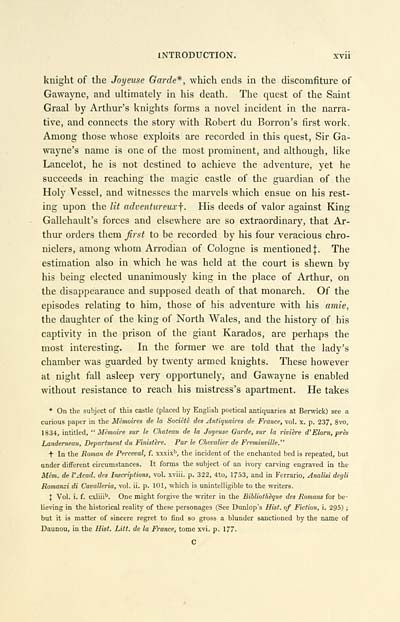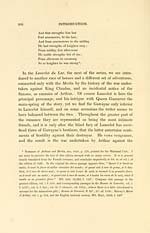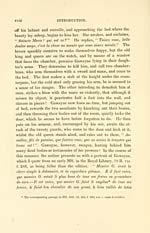Bannatyne Club > Syr Gawayne
(25) Page xvii
Download files
Complete book:
Individual page:
Thumbnail gallery: Grid view | List view

INTRODUCTION. xvii
knight of the Joyeuse Garde*, which ends in the discomfiture of
Gawayne, and ultimately in his death. The quest of the Saint
Graal by Arthur's knights forms a novel incident in the narra-
tive, and connects the story with Robert du Borron's first work.
Among those whose exploits are recorded in this quest, Sir Ga-
wayne's name is one of the most prominent, and although, like
Lancelot, he is not destined to achieve the adventure, yet he
succeeds in reaching the magic castle of the guardian of the
Holy Vessel, and witnesses the marvels which ensue on his rest-
ing upon the lit adventureuxf. His deeds of valor against King
Gallehault's forces and elsewhere are so extraordinary, that Ar-
thur orders them first to be recorded by his four veracious chro-
niclers, among whom Arrodian of Cologne is mentioned {. The
estimation also in which he was held at the court is shewn by
his being elected unanimously king in the place of Arthur, on
the disappearance and supposed death of that monarch. Of the
episodes relating to him, those of his adventure with his amie,
the daughter of the king of North Wales, and the history of his
captivity in the prison of the giant Karados, are perhaps the
most interesting. In the former we are told that the lady's
chamber was guarded by twenty armed knights. These however
at night fall asleep very opportunely, and Gawayne is enabled
without resistance to reach his mistress's apartment. He takes
• On the subject of this castle (placed by English poetical antiquaries at Berwick) see a
curious paper in the Memoires de la Societe des Antiquaires de France, vol. x. p. 237, 8vo,
1834, intitled, "Mi-moire sur le Chateau de la Joyeuse Garde, sur la riviere d' Elorn, pres
Landerneau, Department du Finisthre. Par le Chevalier de Freminville."
f In the Roman de Perceval, f. xxxix b , the incident of the enchanted bed is repeated, but
under different circumstances. It forms the subject of an ivory carving engraved in the
Man. de I'Acad. des Inscriptions, vol. xviii. p. 322, 4to, 1753, and in Ferrario, Analisi degli
Romanzi di Cavalleria, vol. ii. p. 101, which is unintelligible to the writers.
I Vol. i. f. cxliii b . One might forgive the writer in the Bibliothique des Romans for be-
lieving in the historical reality of these personages (See Dunlop's Hist, of Fiction, i. 295) ;
but it is matter of sincere regret to find so gross a blunder sanctioned by the name of
Daunou, in the Hist. Litt. de la France, tome xvi. p. 177.
C
knight of the Joyeuse Garde*, which ends in the discomfiture of
Gawayne, and ultimately in his death. The quest of the Saint
Graal by Arthur's knights forms a novel incident in the narra-
tive, and connects the story with Robert du Borron's first work.
Among those whose exploits are recorded in this quest, Sir Ga-
wayne's name is one of the most prominent, and although, like
Lancelot, he is not destined to achieve the adventure, yet he
succeeds in reaching the magic castle of the guardian of the
Holy Vessel, and witnesses the marvels which ensue on his rest-
ing upon the lit adventureuxf. His deeds of valor against King
Gallehault's forces and elsewhere are so extraordinary, that Ar-
thur orders them first to be recorded by his four veracious chro-
niclers, among whom Arrodian of Cologne is mentioned {. The
estimation also in which he was held at the court is shewn by
his being elected unanimously king in the place of Arthur, on
the disappearance and supposed death of that monarch. Of the
episodes relating to him, those of his adventure with his amie,
the daughter of the king of North Wales, and the history of his
captivity in the prison of the giant Karados, are perhaps the
most interesting. In the former we are told that the lady's
chamber was guarded by twenty armed knights. These however
at night fall asleep very opportunely, and Gawayne is enabled
without resistance to reach his mistress's apartment. He takes
• On the subject of this castle (placed by English poetical antiquaries at Berwick) see a
curious paper in the Memoires de la Societe des Antiquaires de France, vol. x. p. 237, 8vo,
1834, intitled, "Mi-moire sur le Chateau de la Joyeuse Garde, sur la riviere d' Elorn, pres
Landerneau, Department du Finisthre. Par le Chevalier de Freminville."
f In the Roman de Perceval, f. xxxix b , the incident of the enchanted bed is repeated, but
under different circumstances. It forms the subject of an ivory carving engraved in the
Man. de I'Acad. des Inscriptions, vol. xviii. p. 322, 4to, 1753, and in Ferrario, Analisi degli
Romanzi di Cavalleria, vol. ii. p. 101, which is unintelligible to the writers.
I Vol. i. f. cxliii b . One might forgive the writer in the Bibliothique des Romans for be-
lieving in the historical reality of these personages (See Dunlop's Hist, of Fiction, i. 295) ;
but it is matter of sincere regret to find so gross a blunder sanctioned by the name of
Daunou, in the Hist. Litt. de la France, tome xvi. p. 177.
C
Set display mode to: Large image | Transcription
Images and transcriptions on this page, including medium image downloads, may be used under the Creative Commons Attribution 4.0 International Licence unless otherwise stated. ![]()
| Publications by Scottish clubs > Bannatyne Club > Syr Gawayne > (25) Page xvii |
|---|
| Permanent URL | https://digital.nls.uk/82134598 |
|---|
| Description | Place of publication Edinburgh unless otherwise stated. No. 125 is relative to but not part of the club's series. |
|---|---|

